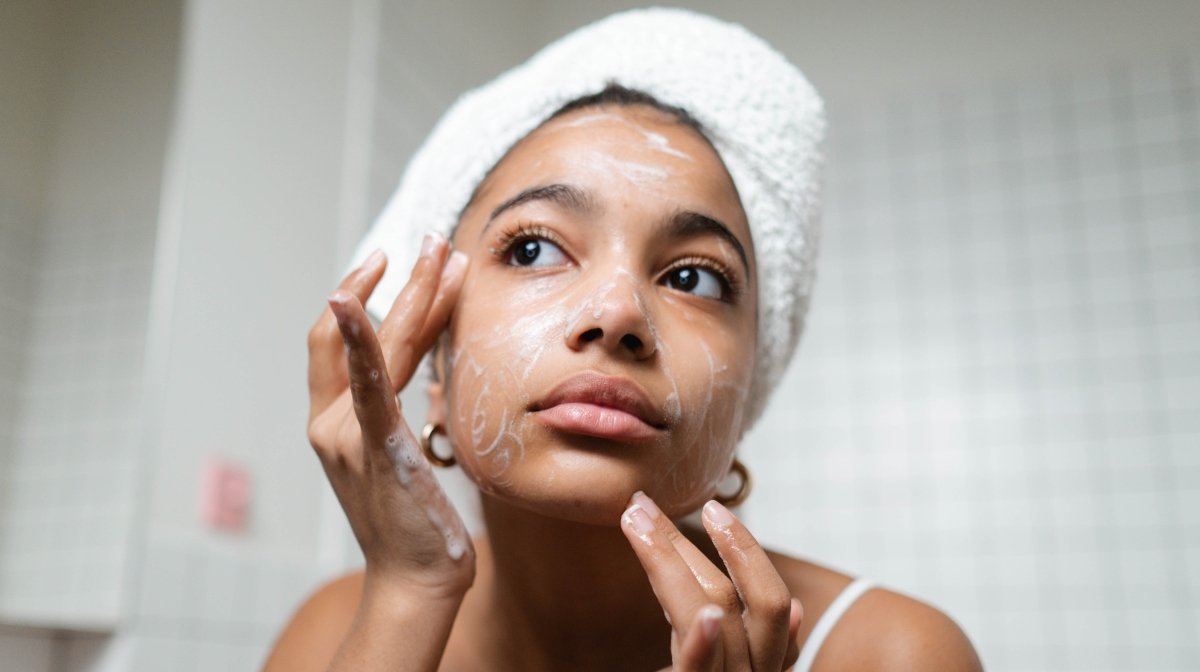Having a skincare routine is essential for maintaining healthy and radiant skin. However, with so many products and steps involved, it can be overwhelming to figure out where to start. If you’re looking to build a skincare routine that suits your skin’s needs, this article is here to guide you. From understanding your skin type to selecting the right products, we’ll cover everything you need to know. So, let’s dive into the steps on how to build a skincare routine that will leave your skin looking and feeling its best.
1. Determine Your Skin Type
The first step to building an effective skincare routine is understanding your skin type. This knowledge will help you choose products that specifically cater to your skin’s needs. The most common skin types are normal, oily, dry, and combination. Normal skin is well-balanced, oily skin produces excess oil, dry skin lacks moisture, and combination skin experiences both oiliness and dryness in different areas. You can determine your skin type by observing how your skin behaves throughout the day and consulting with a dermatologist if needed.
Once you’ve identified your skin type, you can move on to selecting products that address your skin concerns. Keep in mind that your skin may change with time or environmental factors, so be open to adjusting your skincare routine accordingly.
2. Cleanse Your Skin
Cleansing is the foundation of any skincare routine. It eliminates dirt, oil, and impurities that accumulate on your skin throughout the day. When choosing a cleanser, opt for a gentle one that suits your skin type. For oily skin, a foaming or gel cleanser can help control excess oil production. Dry skin benefits from a creamy or milky cleanser that adds hydration. If you have sensitive skin, look for cleansers without fragrances or harsh ingredients.
It’s important to cleanse your skin twice a day – once in the morning and again before bed. Wet your face with lukewarm water, apply the cleanser using gentle circular motions, and then rinse thoroughly. Avoid using hot water, as it can strip your skin of moisture. Pat your face dry with a clean towel, ensuring you don’t rub or tug at your skin.
3. Exfoliate to Reveal Radiant Skin
Exfoliation is a crucial step in any skincare routine as it helps remove dead skin cells and promotes cell turnover, resulting in a brighter and smoother complexion. However, it’s important to exfoliate gently to avoid irritation or damage to your skin. Depending on your skin type and sensitivity, you can choose between physical exfoliators, such as scrubs or brushes, or chemical exfoliators, like AHAs or BHAs.
When exfoliating, be mindful not to overdo it. Exfoliating once or twice a week is generally sufficient, but adjust the frequency based on how your skin responds. Also, remember to moisturize after exfoliating to replenish the skin’s hydration levels.
4. Hydrate Your Skin with a Toner
A toner is a versatile product that helps balance your skin’s pH levels, remove any remaining impurities, and hydrate your skin. It prepares your skin to better absorb the subsequent skincare products you’ll be applying. When choosing a toner, look for one that is alcohol-free and contains hydrating ingredients like hyaluronic acid or glycerin.
Using a cotton pad or your clean hands, apply the toner to your face and neck, gently patting it in. You can use a toner both in the morning and evening after cleansing. Remember, a toner is not a substitute for cleanser, so always cleanse your skin before applying toner.
5. Target Specific Concerns with Serums
If you have specific skincare concerns like acne, hyperpigmentation, or signs of aging, incorporating a serum into your routine can be highly beneficial. Serums are concentrated formulas that penetrate deep into the skin, delivering powerful ingredients that target specific concerns. Look for serums with key ingredients that address your specific needs, such as Vitamin C for brightening or hyaluronic acid for hydration.
To apply a serum, use your fingertips to gently massage it onto your face and neck. Allow the serum to absorb fully before moving on to the next step in your routine.
6. Nourish and Protect with Moisturizer
No skincare routine is complete without moisturizer. Moisturizing is crucial for all skin types, as it helps maintain a healthy skin barrier and prevents moisture loss. Depending on your skin type, select a moisturizer that is lightweight, oil-free, or rich in hydrating ingredients. It’s preferable to opt for a moisturizer with added SPF to provide sun protection during the day.
Apply a dime-sized amount of moisturizer to your face and neck, gently massaging it in using upward motions. Moisturize twice a day, morning and night, after cleansing and applying serums.
7. Don’t Forget the Eye Cream
The skin around your eyes is delicate and requires special attention. Incorporating an eye cream into your skincare routine can help address concerns like dark circles, fine lines, and puffiness. Look for an eye cream that is specifically formulated for the delicate eye area and contains ingredients like caffeine or hyaluronic acid.
Dab a small amount of eye cream onto your ring finger and gently pat it around your under-eye area, moving from the inner to the outer corners. Be careful not to stretch or tug the skin while applying the cream.
8. Sun Protection is a Must
Protecting your skin from the harmful effects of the sun is crucial for maintaining its health and preventing premature aging. Even on cloudy days, UV rays can still penetrate the skin, leading to damage. Therefore, it’s essential to apply a broad-spectrum sunscreen with an SPF of 30 or higher as the final step in your morning skincare routine.
Take a dime-sized amount of sunscreen and apply it evenly all over your face, neck, and any exposed areas. Reapply every two hours, especially if you’re spending time outdoors.
9. Treat Your Skin to Face Masks
Face masks are a treat for your skin, providing targeted benefits depending on the mask’s ingredients. They can help hydrate, brighten, soothe, or detoxify the skin. Incorporate a face mask into your routine once or twice a week to pamper your skin and address specific concerns. Read the instructions on the mask packaging to determine the ideal application time.
After applying the mask to a clean face, relax and let it work its magic. Rinse it off according to the instructions and follow up with the rest of your skincare routine.
10. Listen to Your Skin
Finally, the most important aspect of building a skincare routine is to listen to your skin. Pay attention to how it reacts to the products you’re using. If a certain product causes irritation or discomfort, discontinue its use. It’s crucial to give each new product a fair chance, but if it doesn’t work for your skin, don’t hesitate to find an alternative that suits you better.
Remember, building a skincare routine is a journey, and it may take some time to find the perfect combination of products that work for your skin. Be patient, be consistent, and let your skin guide you along the way.
FAQs
Q: How long does it take to build an effective skincare routine?
A: Building an effective skincare routine is a process that varies for each individual. It may take a few weeks or even a couple of months to see noticeable improvements in your skin. Consistency is key, so stick to your routine and give it time to work.
Q: Is it necessary to use all the recommended skincare products?
A: Not everyone needs to use every recommended skincare product. While the basic steps of cleansing, toning, moisturizing, and sun protection are essential, you can tailor your routine based on your specific skin concerns and preferences.
Q: Can I skip applying sunscreen if my foundation has SPF?
A: It’s not recommended to solely rely on the SPF in your foundation. Most foundations provide inadequate sun protection since you would need to apply a significant amount for it to be effective. To ensure proper sun protection, apply a separate broad-spectrum sunscreen before applying your makeup.
Q: Can I use the same products morning and night?
A: While some products can be used both morning and night, others may serve different purposes depending on the time of day. For example, you may opt for a lightweight moisturizer for daytime use and a richer one for nighttime. Read product labels and instructions to determine if they are suitable for specific times of the day.
Q: How do I know if a product is causing a reaction on my skin?
A: If you notice redness, itching, burning, or any discomfort after using a skincare product, it may be causing a reaction. Discontinue using the product and consult with a dermatologist if the symptoms persist or worsen.
Conclusion
Building a skincare routine tailored to your skin’s needs is a wonderful investment in your skin’s health and overall well-being. Remember to determine your skin type, cleanse properly, exfoliate gently, and hydrate your skin with toners and moisturizers. Target specific concerns with serums, don’t forget the delicate eye area, and always protect your skin with broad-spectrum sunscreen. Treat yourself to a relaxing face mask and most importantly, listen to your skin’s needs and make adjustments as necessary. Embrace the journey of building a skincare routine and enjoy the benefits of healthy and glowing skin.







Leave a Comment